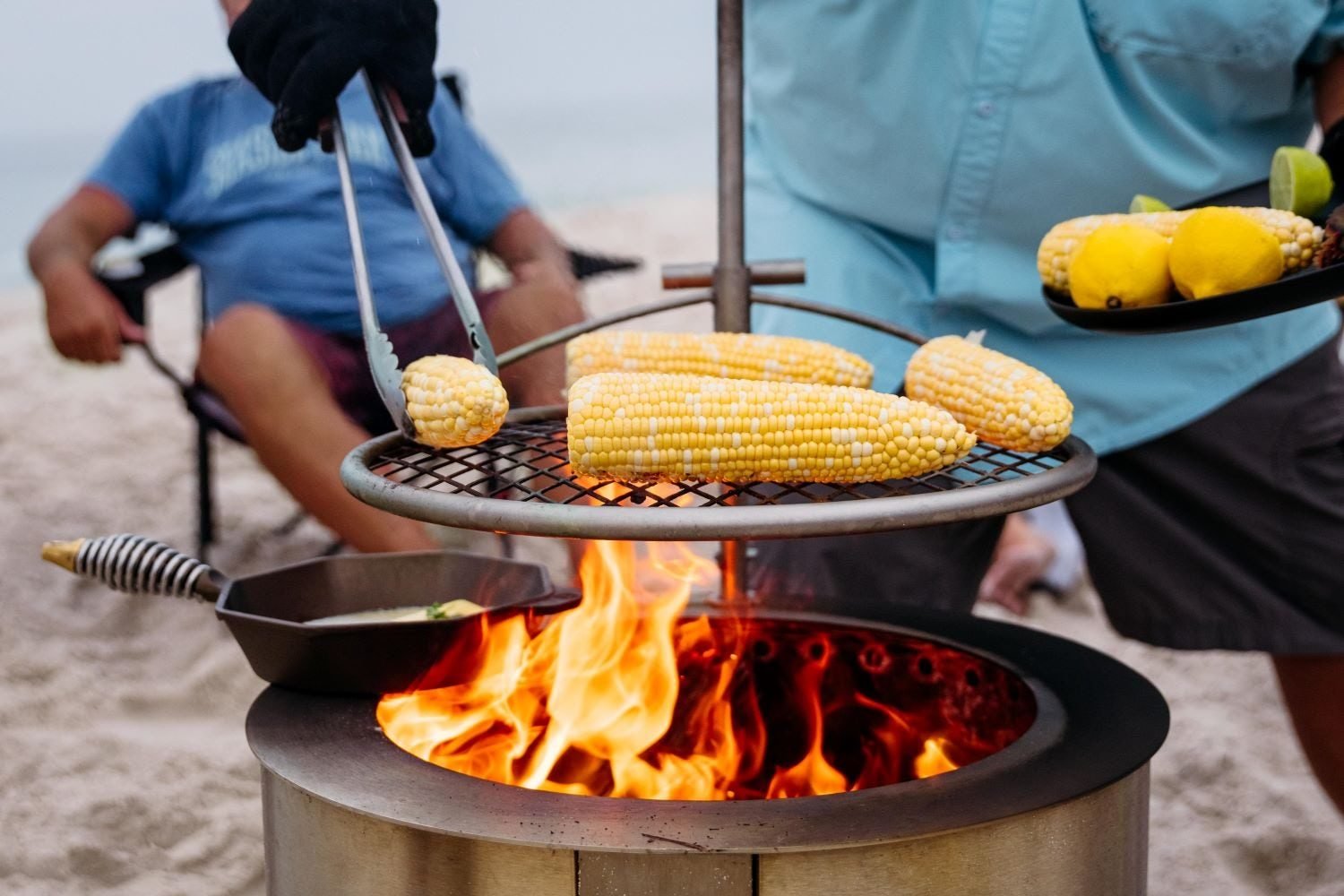Can a portable fire pit handle cooking duties on a camping trip? We'll review your options and share some tips on cooking and cleanup.

Can You Cook on a Portable Fire Pit?

So there you are, working up an appetite while enjoying a walk in the woods or the roaring waves at a beach-side reserve. But when you return to your campsite, you’re face-to-face with a half-corroded fire ring and a rusted-out, tetanus-machine excuse for a grill rack.
Avoid this fate with a portable fire pit and easy-to-use cooking accessories.
On This Page
Types of Portable Fire Pits
Camp stoves are great for cooking, but can’t match a fire pit for enjoying the flames or keeping a campsite warm.
The primary way to classify portable fire pits is by fuel type:
Wood-burning portable fire pits
Wood burners are far and away the most common type. These versatile fire pits can burn anything from sticks to logs, depending on size. They’re a great choice for campgrounds that permit collecting “dead and down” firewood.
Pellet-burning portable fire pits
Wood pellets burn longer than logs and are easier to transport (in bags) than bundled wood. Most wood-burning fire pits can’t burn pellets, which fall through the vent holes, so look for dedicated pellet burners or wood burners with pellet adapters. For more information, check out our review of the Solo pellet adapter.
Gas-fueled portable fire pits
Campers like these for their attractive flames. You can cook on a propane fire pit, but it takes more care. This Bond Signature is a good example. It’s great for producing heat but lacks cooking accessories, and grease can leave a mess on the pumice stones or burner.
Can You Cook on a Portable Fire Pit?
Absolutely! Almost any fire pit produces enough heat to grill, sear, boil or stir-fry. Size comes into play here. The larger the pit, the greater the options, from hot dogs on sticks to three-course meals.
Tabletop fire pits
Ultra-portable or tabletop fire pits are great for warm summer camping and light cooking. Take Solo Stove’s Mesa fire pit. Only five inches in diameter, it’s a wood-burning unit with an optional pellet adapter. An add-on toolkit comes with roasting sticks, stick rests, a pellet scoop, a lid and a carrying case.
The small size of tabletop models limits the heat output and cooking options. Luckily, manufacturers understand the innate need of campers to cook more than s’mores and offer larger models.
Small fire pits
The next step up are fire pits around 10 inches in diameter, with more heat and cooking flexibility. Examples include BioLite’s’s new EcoZoom Versa and Breeo’s wood/pellet hybrid Solo Mesa XL.
The EcoZoom Versa can burn wood or charcoal and its cast-iron cap can hold a skillet or pot. It’s a great choice for cooking up a campsite breakfast.
Portable fire pits
Fifteen inches seems to be the classic size for portable campsite fire pits, providing a balance between heat output and portability. This category includes models like the BioLite FirePit+, the Solo Ranger 2.0, and the Y-Series from Breeo. All offer enough cooking accessories to turn your campsite into a gourmet kitchen.
The Solo and Breeo models come with sear plates and cooking tops that range from griddles and grills to woks. The FirePit+ converts from wood to charcoal fuel, and its cast-iron grate and vented grill lid essentially transform it into a charcoal grill.
Portable Fire Pit Cooking Tips
There’s an art and science to cooking over a fire pit, and every campfire chef develops their own technique. If you’re a beginner, keep two key tips in mind:
- Temperature control: Gas fire pits have a big advantage here — a dial to control flame height, just like a home gas cooktop. Wood-burning fire pits are trickier because the wood burns down over time. For greater control, adjustable-height grill racks plant in the ground or attach to the fire pit itself, letting you bring the grill closer to or farther from the heat.
- Prepare ahead to save time: Prep as much of your meal in advance as possible. It’s much easier to dice veggies or marinate meat at home and then simply lay it out on the fire when you’re ready to cook.
Portable Fire Pit Cooking Safety
When cooking at a campsite, protect yourself, your fellow campers and the nature you’re there to enjoy.
- Fire pits are hot: Keep hands and any flammable materials a safe distance from the fire pit. Be particularly vigilant if you’re camping with children or pets.
- Ashes and embers are hot, even when the fire it out: Gas fire pits are the safest option for this because they leave no ashes or embers. Wood or pellet burners will produce embers and ash, which should be disposed of responsibly.
Post-Cooking Cleanup for Portable Fire Pits
Fire pit manufacturers recommend scraping any grease or oil off cooking surfaces while they’re warm. Ideally, wipe it down with hot, soapy water.
If you don’t have that option while camping, wrap the now-cooled cooking surface in an old towel to keep any grease off the rest of your gear. Some fire pits come with a carrying bag to keep things tidy and organized.
Many fire pits have clean-outs to make ash disposal easier. If possible, wait until the morning to dispose of any ashes, giving them time to cool down. Be sure to douse the ashes with water to ensure you leave no embers behind that can start a fire.



















